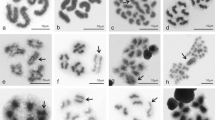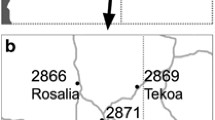Summary
-
1.
The tropical species of the genus Thyanta conform, in their chromosome formula (2n♂=12+XY, 2n♀=12+2X), to that which is typical for the Family of Pentatomidae (Hemiptera), while the more northern species examined by us have either added a pair of chromosomes (T. custator and T. pallidovirens) or have doubled the basic number (T. calceata).
-
2.
Hybrids between T. custator and T. pallidovirens show only minor disturbances in their meiosis, and the hybrid spermatids carry the same number of chromosomes and amount of DNA as are present in the spermatids of either parent species.
-
3.
The meiosis of the hybrid between T. calceata and T. pallidovirens is quite abnormal and there is no chromosome pairing. Nevertheless, chromosome segregation is not completely at random and some functional sperms are formed.
-
4.
The nuclei of the six species of Thyanta tested show little difference in their DNA contents. On the other hand, the nuclei of another pentatomid, Arvelius, contain at least twice as much DNA.
-
5.
In considering the evolutionary origin of such a high chromosome number as that of T. calceata, the evidence adduced in the present investigation more or less precludes the involvement of polyploidy. Instead, some type of fragmentation was probably responsible for the doubled number.
-
6.
It is difficult to conceive of such fragmentation as occurring transversely through the chromosomes. We propose a consideration of “longitudinal fragmentation” or better, a separation of the chromatids of each chromosome and the establishment of “echromatid autonomy”.
-
7.
Except where polyploidy is involved, great differences in the nuclear contents of DNA, as observed between some Classes and Orders, must in certain cases be due to different degrees of polyteny and not to the addition of new or different genes. Our evidence demonstrates that relatively large differences of DNA may also exist in systematic groups of a lower category, such as the Genera of the same Tribe, or perhaps even the Species of the same Genus. On this basis, the degree of polyteny may differ even in closely related forms.
Similar content being viewed by others
References
Ansley, H. R.: A cytological and cytophotometric study of alternative pathways of meiosis in the house centipede (Scutigera forceps Rafinesque). Chromosoma 6, 656–695 (1954).
Barber, H. G.: The resurrection of Thyanta calceata Say from synonymy. J. N. Y. Entomol. Soc. 19, 108–111 (1911).
Bauer, H.: Karyologische Notizen I. Z. Naturforsch. 2b, 63–66 (1947).
Bauer, H., u. W. Beermann: Die Polytänie der Riesenchromosomen. Chromosoma 4, 630–648 (1952).
Bowen, R. H.: Notes on the occurrence of abnormal mitosis in spermatogenesis. Biol. Bull. 43, 184–203 (1922a).
—: Studies on insect spermatogenesis II. J. of Morph. 37, 81–193 (1922b).
Darlington, C. D., and K. Mather: The elements of genetics. London: Allen a. Unwin 1949.
Geitler, L.: Endomitose und endomitotisohe Polyploidisierung. Protoplasmatologia, Bd. VIC, S. 1–89. 1953.
Heizer, P.: The chromosome cytology of two species of the Pacific genus Oechalia (Pentatomidae, Hemiptera-Heteroptera), Oechalia patruelis Stal and Oechalia pacifica Stal. J. of Morph. 87, 179–226 (1950).
Hughes-Schrader, S.: Cytology of coccids (Coccoïdea-Homoptera). Adv. Genet. 2, 127–203 (1948).
—: The desoxyribonucleic acid content of the nucleus as a cytotaxonomic character in mantids (Orthoptera: Mantoidea). Biol. Bull. 100, 178–187 (1951).
—: The nuclear content of desoxyribonucleic acid and interspecific relationships in the mantid genus Liturgousa (Orthoptera: Mantoidea). Chromosoma 5, 544–554 (1953).
Hughes-Schrader, S., and H. Ris: The diffuse spindle attachment of coccids, verified by the mitotic behavior of induced chromosome fragments. J. of Exper. Zool. 87, 429–456 (1941).
Jensen-Haarup, A. C.: On the genus Thyanta. Entomol. Meddelser 16, 183–291 (1928).
Kirkaldy, G. W.: Catalogue of the Hemiptera (Heteroptera) I. Berlin: Felix L. Dames 1909.
Lorkovic, Z.: Die Chromosomenzahlen in der Spermatogenese der Tagfalter. Chromosoma 2, 155–191 (1941).
—: Chromosomen-Vervielfachung bei Schmetterlingen und ein neuer Fall fünffacher Zahl. Rev. suisse Zool. 56, 243–249 (1949).
McClintock, B.: The fusion of broken ends of sister half-chromatids following chromatid breakage at meiotic anaphases. Univ. Missouri Coll. Agri. Bull. 290, 1–48 (1938).
—: The behavior in successive nuclear divisions of a chromosome broken at meiosis. Proc. Nat. Acad. Sci. 28, 458–463 (1939).
Mickey, G. H.: Synapsis and behavior of chromosomes in polyploid male germ cells of Romalea microptera (Beauv). Rec. Genet. Soc. 13, 27–28 (abstract) (1944).
Mirsky, A. E., and H. Ris: The desoxyribonucleic acid content of animal cells and its evolutionary significance. J. Gen. Physiol. 34, 451–462 (1951).
Muller, H. J.: Why polyploidy is rarer in animals than in plants. Amer. Nat. 59, 346–353 (1925).
Nordenskiöld, H.: Cytotaxonomical studies in the genus Luzula I. Hereditas 37, 325–355 (1951).
Ris, H.: A cytological and experimental analysis of the meiotic behavior of the univalent X chromosome in the bearberry aphid Tamalia (Phyllaphis) coweni (Ckll). J. of Exper. Zool. 90, 267–330 (1942).
Ruckes, H., and R. I. Sailer: The taxonomic status and distribution of Thyanta custator (Fabr.) and Thyanta pallidovirens (Stal.). American Mus. Novitates (in press) 1956.
Schrader, F.: The chromosome cycle of Protortonia primitiva (Coccidae) and a consideration of the meiotic division apparatus in the male. Z. Zool. 138, 386–408 (1931).
—: The elimination of chromosomes in the meiotic divisions of Brachystethus rubromaculatus Dallas. Biol. Bull. 90, 19–31 (1946a).
—: Autosomal elimination and preferential segregation in the harlequin lobe of certain Discocephalini (Hemiptera). Biol. Bull. 90, 265–290 (1946b).
—: The role of the kinetochore in the chromosomal evolution of the Heteroptera and Homoptera. Evolution 1, 134–142 (1947).
Troedsson, P. H.: The behavior of the compound sex chromosomes in the females of certain Hemiptera Heteroptera. J. of Morph. 75, 103–147 (1944).
Vandel, A.: Chromosome number, polyploidy, and sex in the animal kingdom. Proc. Zool. Soc. Lond. 107, 520–541 (1938).
Warmke, H. E., and A. F. Blakeslee: Sex mechanism in polyploids of Melandrium. Science 89, 391–392 (1939).
Westergaard, M.: Studies on the cytology and sex determination in polyploid forms of Melandrium album. Dansk. bot. Ark. 10, 1–131 (1940).
White, M. J. D.: The evidence against polyploidy in sexually reproducing animals. Amer. Nat. 80, 610–618 (1946).
—: Animal cytology and evolution, 2nd Ed. Cambridge: University Press 1954.
Wilson, E. B.: Polyploidy and metaphase patterns. J. of Morph. 53, 443–471 (1932).
Author information
Authors and Affiliations
Rights and permissions
About this article
Cite this article
Schrader, F., Hughes-Schrader, S. Polyploidy and fragmentation in the chromosomal evolution of various species of Thyanta (Hemiptera). Chromosoma 7, 469–496 (1955). https://doi.org/10.1007/BF00329739
Received:
Issue Date:
DOI: https://doi.org/10.1007/BF00329739




